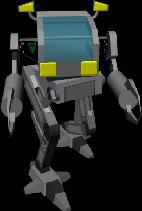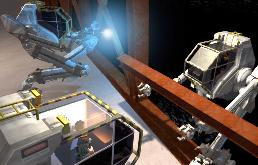
Mechanized Propulsion Systems,
Rosamond, CA, Terra. | Mechanized Propulsion System Construction Robot Mark V. | 
Mechanized Propulsion Systems,
Rosamond, CA, Terra. |
|---|
| This incredibly robot was First introduced just before the Global Civil War, and was used extensively through the First and Second Robotech Wars and both Invid Invasions to rebuild the world. After the GCW, the United Earth Government contracted out to Mechanized Propulsion Systems to build 100 of the robots for "critical infrastructure rebuilding" (roads, bridges, hospitals, and certain government buildings).After the Rain of Death and the end of the First Robotech War, MPS was again turned to to build these robots and to repair those that survived the War to rebuild once again. During this chaotic period, a few fall into the hands of rebels and bandits; Their attempts to modify these as combat Mecha were proven to be inferior to even soldiers on the ground.This pattern repeated after the Second Robotech War (the Southern Cross Era), though more of them fall into criminal hands; These attempts proved equally inept, and only serve to provide the would-be victims with machines to rebuild their villages.During the both Invid Invasions, a few of these machines, old and beyond mechanical limits, were used to help maintain what few villages have got them. The village of Bakersfield, though decimated during the Rain of Death, became a smallish industrial center. Since they produce nothing but civilian goods, and are sufficiently away from Invid Farms and properties, the village is largely left alone. MPS continued to manufacture the robots, though it does more in making parts for those who request them. During the Second Invid Invasion, production was ramped up under the less intense Invid presence.Military models can never be made; Though legend has it that the actuators were developed, the blueprints were destroyed during the Rain of Death. The critical flaw was in the knee and hip actuator assemblies; They were not strong enough to support the amount of armor necessary to make them practical War machines for any extended period of time. This failure also made them unworkable as law enforcement platforms, though this would fortuitously have no effect whatsoever in fire fighting applications. No attempt to overcome this failure was ever successful; All such were either still too weak to support the armor, too stiff to allow the kind of movement necessary, or given to jamming under stress- Any one of which is a deadly flaw to a War machine in and of itself.The robots are destined to be construction and other heavy labor machines; THE machine turned to for rebuild after each catastrophe.Name: MPS Mark VModel Type: RobotClass: ConstructionManufacturer: Mechanized Propulsion Systems (headquarters Bakersfield, CA, US, Terra).Crew: One.Passengers: None.SDC By Location: |
Torso-
Upper Legs-
Lower Legs- | 200
75 each
100 each | Upper Arms-
Lower Arms-
| 60 each
80 each
|
| Speed and Statistical Data: |
Running Speed: 160 MPH.
Range: 200 miles before refueling; Due to this limitation, it is generally preferred to transport the Mark V on a flatbed vehicle.
Powerplant: Twin 350 cubic inch hydro-cell engine; Output: 500 Horsepower.
Physical Strength: Equal to a PS of 90.
Physical Prowess: Equal to a PP of 9.
Physical Endurance: Equal to a PE of 90.
Height: 7 feet.
Width: 8 feet. | Length: 4 feet
Weight: 5 tons
Cost and Availability: Really cheap; 50,000credit each (that's LESS than a heavy construction crane on average); Always.
Black Market Cost and Availability: Stolen ones run around 10% normal price. Used ones generally get 50% normal price; Rare; These machines are FAR too valuable to lose, and the risks involved with stealing and fencing them just aren't generally worth the effort.
|
Weapons Systems:Hand to hand attacks only: Mounting weapons of any sort on these robots, while doable, simply isn't worth the effort as any guns heavy enough to require such a platform are simply too heavy for the arms and legs to support.
Attack Per Melee: 2; They're also too slow to fight.
Punch: 3D4 times 100 SD
Kick: 1D4 times 100 SD
Body Block: 75% chance of knocking down and enemy robot of comparably weight; 0% chance of knocking down combat Mecha or tanks/power armors. |
| Features: |
- Radar: Civilian grade radar; Range: 10 miles; Target track: Up to 1 dozen targets. Reliability: 75% standard (no effect on stealthed vehicles).
- FLIR/SLIR: Forward and Side Looking Infrared. Allows pilot to see in terms of heat characteristics (especially useful in welding.
- Motion Detector: Activates a loud wailing when an object is coming at the user fast, and a soft ringing if it's coming slowly. Activation ranges must be specified by the operator.
- Video Camera: Records from the HUD.
- Optic sensory suite: Infrared: Range 50 feet. Magnification: Range 50 feet. Thermal imager: Range 5 feet. Toggle Sight: A goggle systems allows the pilot to view certain systems without having to look down; Ties into all other sensors.
- SKA 6161 wide band radios: Standard Civilian Band working range radio; Effective Range: 10 mile. Works on standard radio band wavelengths, so it can still be jammed or tapped (if the enemy knows the frequencies).
- Loudspeaker: Amplifies voice 1 to 100 times. 100 feet in normal crowds. Mostly used to tell ground crews what the pilot is doing. Can be muted at the push of a button.
- External Microphone: Allows the pilot to hear what ground crews are saying and doing. Can be muted at the push of a button.
- AM/FM Radio/CD Player: Reduces pilot boredom. Can be toggled into the loudspeaker.
- Blast Proof Plating: Only standard for demolitions models; MDC: 200.
- Water Tight Cockpit: Only standard on underwater construction models.
- Air Tight Cockpit: Only standard on space construction models.
- Power Windows/Locks: To ease pilot's labor.
- Anti-Theft Alarm/Lowjack System: These robots are FAR too expensive to risk them being stolen. The alarm system ties into the locking joints, preventing the robot from being moved easily; The lowjack allows it to be tracked after theft and ties into the GPS. Both units are hardwired into the mainframe computer, preventing easy removal.
| - Telescoping Arms: Extends the reach by 40 feet.
- Fire Resistance: Fires external to the robot are not felt at all. Only standard on fire fighting and space construction models.
- Grav Clamps: Allow the robot to adhere to any solid (and some liquids) in the known universe.
- Oxygen Rebreather System: Extends air supply to 20 hours; Cartridge MUST be replaced after that period of time. Only standard on space and underwater construction models, Hazmat models, and some fire fighting models.
- Internal temperature and humidity control: Automatically maintains users desired heat, humidity, and other personal comfort settings. Construction pilots usually just open the windows. (Also known as "Heating And Air Conditioning.")
- Heat And Radiation Shielding: Special shielding prevents the penetration of life threatening heat and radiation. Only standard on space construction models.
- Variable Tint Cockpit Canopy: Adjusts tinting to light conditions, up to an including a black dot if the sun is directly on the viewers face (only covers eyes).
- Vacuum Seal: Permits use in hard vacuum (such as outer space), and other hostile environments. Only standard on space construction models.
- Spotlight: Allows pilot to see in the dark. Useful Range: 50 feet. Covers an area about 20 cubic feet effectively.
- GPS: Standard tracking device. Ties into the ground crew tracker.
- HUD: Displays maps, radar, targeting information, and any OTHER information the user wants directly in front of them.
- Ground Crew Tracker: Tracks the ground crew. Overlays the information on both the radar and HUD, ensuring that friends are not accidentally trampled/crushed.
- Virtual Map: Displays a continuously-updating map of local terrain for the pilot. Takes data from and gives data to other friends in the area. Effective land navigation of 85% as updates come. Good to 500 miles. Specific range can be adjusted in 1 mile increments.
|
| Other Equipment:User-installed equipment. |
_________________________________________________________
_________________________________________________________
_________________________________________________________
_________________________________________________________
_________________________________________________________
_________________________________________________________ | _________________________________________________________
_________________________________________________________
_________________________________________________________
_________________________________________________________
_________________________________________________________
_________________________________________________________ |
| Combat Profile For MPS Construction Robot MkV:The MPS MkV is NOT a combat vehicle; You're better off fighting on foot. 02 Attack Per Melee -5 Strike, Parry, Dodge, and Roll. |



